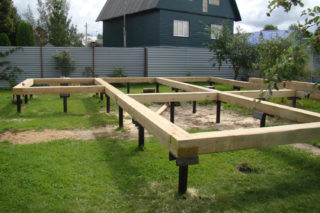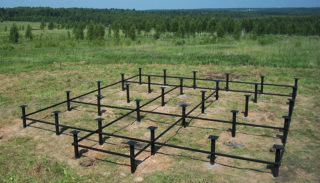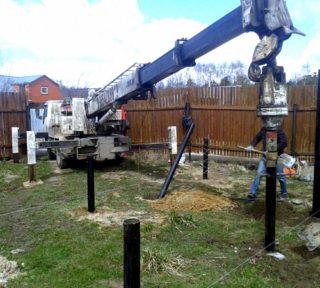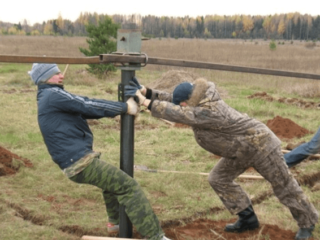Installation of a pile-screw foundation is a fairly common technology that is gaining popularity in private construction. This method of arranging support systems is not new, but became available only a few years ago due to the rapid development of technical progress and the reorientation of industry to meet the needs of the population. The installation of screw piles is not particularly difficult, but it requires certain concepts regarding the choice of products, the rules for their preparation, installation and subsequent operation.
Features and benefits of screw piles

Screw piles are a hollow metal tube with a tip, blades and technological holes for transferring force to the product when it is screwed into the ground. As part of the foundation system, submerged rods perform a holding and supporting function, due to the strength of the structure and stability in the ground due to the large support area.
The pile device has the following features:
- type - solid and prefabricated;
- screwing type - bladed, spiral, combined;
- the number of blades - a pair, several spirals;
- tip - cast, welded, forged;
- material - stainless steel, black iron with anti-corrosion coating.
Installation of a pile foundation gives developers the following advantages:
- Protection of the house from pressure and soil displacement that occurs during frost heaving. The blades fall below the freezing point of the soil.
- Durability due to the use of materials that are resistant to moisture, acid, alkali and other reagents contained in the earth.
- Profitability. Installation of screw piles is 30-40% cheaper than driving reinforced concrete pillars or pouring monolithic foundations.
- Wide range of applications. The products can be used on almost all types of soil except rocky ones. In addition, the installation of piles allows you to minimize or completely eliminate excavation when working on slopes and uneven areas.
- No vibration and noise when screwing into the ground. The only source of sound can be the engine of a special technique.
- The ability to carry out the construction of the foundation in the cramped conditions of the city and a landscaped frequent site. Applicability to the arrangement at any time of the year.
- Reusability. If the protective coating is restored, the piles can be used up to 5 times.
An undoubted advantage for private developers is the technology for installing the foundation. It is allowed to twist the supports manually, for which a lever and the force of 2-3 people are used. This method is applicable to pipes with a diameter of up to 108 mm.
Determination of pile length

The installation of piles under the foundation is carried out after examining the soil and determining its bearing capacity. In addition, the seismic activity in the region and the level of groundwater are taken into account. When working on unstable soil, swampy terrain or the bottom of a reservoir, the level of occurrence of solid soil is determined, the parameters of which correspond to the conditions set by the project.
The main rule of installation is that the tip with the blades should be 15-20 cm below the horizon of soil freezing. It should be borne in mind that part of the pipe with technological holes for rotation after installation must be cut off.
Manufacturers produce screw piles from 1.65 m to 12 m in length.One section for private construction is produced up to 2.6 m in size.To achieve greater depth (on slopes, clay soil, quicksand), standard products are built up with additional sections or pipes of the same diameter by welding the edges.
Screw pile driving options
The method of driving the piles into the soil is determined by its properties and the height of the sections.
There are such installation options:
- With preliminary drilling. This method is used on dense soils, where its resistance exceeds the tensile strength of the blades and their attachment to the pipe. Installation is carried out in two stages. First, a borehole is made with a diameter corresponding to the pipe or slightly smaller in order to ensure its tight compression. Then the section is installed in the hole with a tip and twisted until it reaches the design depth. If drilling a well is difficult, the process can be mechanized using a motorized device. An illustrative example of such a technology is metal threading using a die and a tap.
- Screwing in without preliminary preparation. Such installation of piles is carried out on soft soils, where there is no risk of damage to the product when exposed to excessive force. A small hole is made in the upper layer of the soil to capture the earth with the blades, then the column is rotated until it drops to a predetermined level. This technique is similar to screwing in a self-tapping screw with a hex head with a Phillips screwdriver. Here you need to carefully deal with the density and hardness of the earth. Excessive force exerted by a mechanical device or a long arm can break and deform the blades. In addition, strong friction against hard rock causes the anti-corrosion coating to peel off from the metal.
You can mount the supports yourself or with the assistance of specialists. The choice depends on your own building skills, physical fitness and the possibility of involving assistants in this business.
The process of driving piles into the ground

To properly install the pile foundation, you must carefully consider the installation of each support. The slightest deviation from technology leads to a weakening of its bearing capacity and further difficulties with strapping.
When screwing the sections into the ground, the following sequence of work should be followed:
- Transfer the drawn up drawing to the site. It is necessary to orient it to the cardinal points, then precisely set the angles in accordance with the distances from stationary objects - a fence, a house, a shed, a well.
- Align corners precisely. For this, a cord, stakes and a tape measure are used. The compliance of the diagonals is checked without fail - they should not differ by more than 1%.
- Outline the location of the supports. They must be located exactly under the centerline of the grillage, which will be installed at the end of the installation of the pile field. Displacement can lead to a deviation of the center of gravity and deformation of the entire support system.
- Dig pile pits. Depending on the type of soil, their depth can be 30-50 cm. Recheck the correctness of the preparatory measures taken. Lay out the supports opposite the pits, mark them on them, which will indicate the immersion depth.
- Insert the piles into the pit one by one, press down and level them, changing the level every 90 degrees. Screw in the products using mechanical or manual tools. During lowering, the product must not be tilted to the side or twisted back.
- Take a hydraulic level or a laser device and align the pipes protruding from the ground in height. Cut off the tops using a grinder, gas cutter or hand saw.
- It is not necessary to knead the concrete mortar, to reinforce the pile, since this function is performed by its outer body. Pour the mortar using a vibrator or steel bar to remove air bubbles. Align the mortar along the upper edge of the pipe.
- Weld the heads to the cuts of the supports. This must be done carefully to ensure the horizontal and vertical correspondence of the details.
- Clean welds and cuts from scale, rust and dirt. Cover them with a protective coating. Wait until it is completely dry.
Further work can be continued immediately, without waiting for the concrete to completely harden. This factor does not affect the bearing capacity of the support system.
Subtleties and do-it-yourself installation technology

Despite the seeming simplicity of the technology, the installation of the screw structure has a number of features that must be taken into account in the design process and during installation.
- Regardless of the type of soil, the immersion depth of the supports should be below the level of its freezing. For the middle and southern strip of the country, it is 150 cm. This will prevent the squeezing out of the rods when the soil heaves.
- The distance between the piles for a frame house is taken no more than 250 cm. Increasing the step leads to sagging of the timber, which is used to equip the base for the walls. Even a reinforced concrete grillage can deform over time.
- To install the piles manually, you need at least three people. One is responsible for the vertical position of the support, and two are engaged in screwing it in.
- Screwing in the supports is a very difficult process that requires considerable physical effort. To make it easier, you need to increase the lever arm. As a standard, scrap is inserted into the technological holes of the pile. If its length is not enough, steel pipes are pushed onto the ends. Their length can be up to 400 cm. Usually the length of the arm is 3-4 meters. The longer it is, the less effort workers will have to spend.
- You must immediately install the support in an upright position. The allowed deviation is 1 degree.
With proper planning, the pile system can last up to 100 years, provided a high-quality protective coating is applied. When the building falls into disrepair, the screw supports can be unscrewed and further use can be found.








